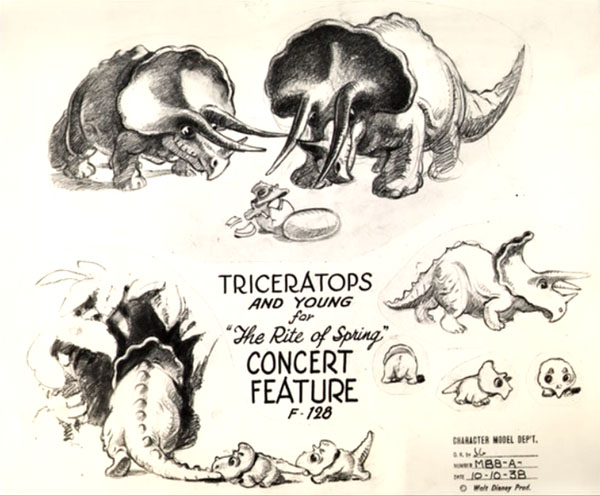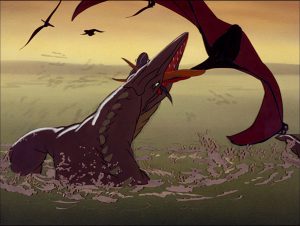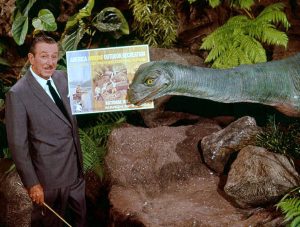 Suspended Animation Bonus Column
Suspended Animation Bonus Column
Today, Disney park guests can experience realistic three-dimensional audio-animatronics dinosaurs at various Disney theme parks.
Walt Disney’s fascination with making dinosaurs “real” goes back several decades to the animated feature Fantasia in 1940. Disney transformed prehistoric monsters that had been extinct for centuries into living, breathing creatures using the most accurate information available at the time.
Walt said he wanted the Rite Of Spring section with dinosaurs to look “as though the studio had sent an expedition back to earth six million years ago.” The studio contacted museums and world famous authorities like Roy Chapman Andrews, Julian Huxley, Barnum Brown, and Edwin P. Hubble with detailed requests for information.
Disney animators were confronted with the challenge of how to draw a dinosaur in movement. The director told the puzzled animators to “just draw a 12-story building in perspective, then convert it into a dinosaur and animate it.”
Cartoonist Winsor McCay had solved some of his problems with animating a dinosaur by timing himself doing actions like inhaling and exhaling.

Walt told the animators, “Don’t make them cute animals. Make them real.” To help achieve a sense of size, the camera level was kept low so audiences were always looking up at the massive animals.
Paleontologists had reconstructed skeletons of the extinct giants but how does a Stegosaurus tail move and what was the skin texture and skin color like? Disney animators had to use their knowledge of balance and weight and color and were able to create a reasonable approximation that garnered accolades in the scientific community.
Pterodactyls took flight while a herd of Brontosauruses quietly grazed in a lake and a fierce Tyrannosaurus Rex threatened the peaceful scene in the film, and those images were later translated into three dimensions at the Disney theme parks.
 Time magazine reported when the film was released: “The New York Academy of Science asked for a private showing because they thought [Fantasia’s] dinosaurs better science than whole museum loads of fossils and taxidermy.”
Time magazine reported when the film was released: “The New York Academy of Science asked for a private showing because they thought [Fantasia’s] dinosaurs better science than whole museum loads of fossils and taxidermy.”
Walt Disney was always looking for ways to capitalize on his existing product to help generate more revenue for various other projects.
An official 16mm film division (later renamed Walt Disney Educational Media) was established with Carl Nater in charge in 1945. Nater had been the production coordinator on the Disney military training films and the health films during the war.
Originally, the division rented Disney shorts and features to local schools and organizations for fund raising. Nater remained in charge of the 16mm film division for more than two decades.
Schools or organizations could rent Disney features to show in the classroom or as fundraisers. Nater assured the theatrical film venues that Disney would not even permit schools or PTAs to schedule renting Disney 16mm films on Saturdays since it was considered in direct conflict with motion picture theaters.
Nater also looked at ways to configure existing material for education purposes like releasing in 1955 the Rite of Spring dinosaur segment from Fantasia with new narration and entitling it A World is Born.
This newly edited version was released to schools to be used in science classes. Stephen Jay Gould, who went on to become one of the century’s great evolutionary biologists, claimed that he became enthused with dinosaurs as a child thanks to seeing this film in school.
However, the film was withdrawn from distribution because of complaints that it “promoted evolution”, a similar complaint when Nater tried to release a segment from Ward Kimball’s Mars and Beyond.
Around 1968, the Disney 16mm film rental division became the Walt Disney Educational Media Company with Nater as the president operating out of an office in Glendale, California.
The company was making close to a million dollars a year renting and selling films and filmstrips to schools. WDEMCO was an independent subsidiary of Walt Disney Productions and by 1973 was generating over ten million dollars a year in revenue.
One of the most memorable scenes in A World is Born as well as the original feature included a climactic battle between a Stegosaurus and a vicious, red-eyed Tyrannosaurus Rex that could never have happened, since those animals lived in different eras.
It was such an iconic scene that it became an integral part of tableaus at both Disneyland and Walt Disney World.
Animating dinosaurs for the very first time in full Technicolor was just the first step for Walt. His next step into the prehistoric world wouldn’t be for another two decades but it was a big step: animating actual gigantic physical dinosaurs. While World’s Fairs had had full-sized representations of dinosaurs before, nobody could do it like Walt.
For the Ford Motor Company’s 1964 World’s Fair Pavilion Walt thought bigger than anyone. He had Imagineers Claude Coats, Marc Davis, and Blaine Gibson devise a prehistoric world with dinosaurs and cavemen.
These full-sized dinosaurs were sculpted backstage at Disneyland in a pre-fab building with an 18-foot doorway to get the figures in and out.
 Gibson, who would later sculpt pirates and presidents, supervised sculptors like Howard Ball, who had sculpted dinosaurs for the La Brea Tar Pits, and former Yale art professor George Snowden. Gibson concentrated on the facial areas: “We are drawn to the head. When we look at a wild animal we are drawn to the eyes.”
Gibson, who would later sculpt pirates and presidents, supervised sculptors like Howard Ball, who had sculpted dinosaurs for the La Brea Tar Pits, and former Yale art professor George Snowden. Gibson concentrated on the facial areas: “We are drawn to the head. When we look at a wild animal we are drawn to the eyes.”
Walt always dropped down to the building to look at the progress on the dinosaurs. Marc Davis came up with the idea of the Triceratops babies coming out of their shells. Jimmy MacDonald provided some of the savage howls and roars and was unable to speak for Mickey Mouse for quite awhile afterward.
These Disney dinosaurs premiered at the World’s Fair on April 22, 1964 – in Walt Disney’s Magic Skyway. When the fair closed in 1965, the dinosaurs, after failed attempts to get Ford to sponsor a pavilion at Disneyland, were relocated to the only area that could hold them, the grand finale of the Grand Canyon Diorama on the Santa Fe & Disneyland railroad.
Forty-six audio-animatronics dinosaurs were relocated to the west coast and installed as a glimpse into what the Grand Canyon may have looked like millions of years ago. The new addition debuted in July 1966. Once again, the climax was the battle between the Tyrannosaurus Rex and the Stegosaurus in a bubbling lava-filled environment.
Over the decades other audio-animatronics dinosaurs popped up at the Disney theme parks from the Universe of Energy at Epcot to the Dinosaur attraction at Disney’s Animal Kingdom but it all began with the Fantasia dinosaurs.



 Jim Korkis is an internationally respected animation historian who in recent years has devoted his attention to the many worlds of Disney. He was a columnist for a variety of animation magazines. With his former writing partner, John Cawley, he authored several animation related books including The Encyclopedia of Cartoon Superstars, How to Create Animation, Cartoon Confidential and Get Animated’s Animation Art Buyer’s Guide. He taught animation classes at the Disney Institute in Florida as well as instructing classes on acting and animation history for Disney Feature Animation: Florida.
Jim Korkis is an internationally respected animation historian who in recent years has devoted his attention to the many worlds of Disney. He was a columnist for a variety of animation magazines. With his former writing partner, John Cawley, he authored several animation related books including The Encyclopedia of Cartoon Superstars, How to Create Animation, Cartoon Confidential and Get Animated’s Animation Art Buyer’s Guide. He taught animation classes at the Disney Institute in Florida as well as instructing classes on acting and animation history for Disney Feature Animation: Florida.




















































Interesting that Disney sought information on dinosaurs from Roy Chapman Andrews of the American Museum of Natural History. I had several of Andrews’s ALL ABOUT books for young people when I was growing up, including ALL ABOUT DINOSAURS. While most of the dinosaurs in Fantasia are North American varieties, there is one Asian species: little Protoceratops, which Andrews discovered on his Gobi Desert expedition in the 1920s.
I wonder if Disney thought to consult with scientific illustrators who specialised in prehistoric life. The foremost one at the time was Charles R. Knight, who created murals and paintings for major American museums as well as book illustrations. The February 1942 issue of National Geographic had a series of 24 full-colour plates by Knight depicting the history of life on earth, suggesting that public interest in the subject was very high at the time. At minimum it seems that Disney’s artists must have studied Knight’s artwork in the Natural History Museum in Los Angeles; the composition of some of the scenes is markedly similar to Knight’s work.
Disney’s dinosaurs weren’t the only ones on display at the 1964 World’s Fair. Sinclair Oil had commissioned a set of life-sized dinosaur models from Louis Paul Jonas, a taxidermist and sculptor who had collaborated with Knight in designing museum exhibits. Jonas hoped to establish a museum of prehistoric life, but Sinclair withdrew its sponsorship and he couldn’t find another. The dinosaurs themselves have been sold or donated to various museums and parks. Two of them are in Dinosaur Valley State Park in Texas; I found a lot of fossil clamshells and belemnites there, but no dinosaur remains.
Since “A World Is Born” was withdrawn from circulation to schools because it “promoted evolution”, does Disney now distribute the Noah’s Ark segment from Fantasia 2000 to Christian schools for use in their “science” classes?
Didn’t John Hubley directed “The Rite of Spring” sequence?
Bill Roberts and Paul Satterfield directed “The Rite of Spring” sequence. Hubley was involved only in the layout of that segment, along with McLaren Stewart and Dick Kelsey.
(Source: “The Animated Film Encyclopedia” 2nd ed., 2011, by Graham Webb. Entry no. 1885 – “Fantasia,” obviously – pp. 107-8.)
Excellent background, good job.
“A World is Born” may have been withdrawn from Disney’s list of strictly educational films, but it remained in 16mm rental catalogues for many years and was available for non-theatrical rental from Disney and 16mm sub-distributors at least through the late 1970s.
Probably they watched the 1933 version of “King Kong” several times, as it basically served as a template for what they were trying to accomplish.
Thank you for this. Even now that I’m old, I still get excited seeing stuff about dinosaurs and prehistoric mammals.
What is especially fascinating about this sequence today is that it’s a “snapshot” of what was state-of-the -art paleontology at that time. Since then, much has been discovered about just how dinosaurs looked and moved and may have interacted. Particularly, the scenes of the demise of the dinosaurs has been overtaken by the evidence of the results of the Chicxulub asteroid impact as key extinction-level event.
And the film is also a fascinating depiction of how major geological events occurred before the theory of plate-tectonics was widely accepted.
For the most part, yes, but some things in the film are contrary to then-current scientific knowledge. For example, the sudden emergence of the mountain range at the end contradicts the theory of uniformitarianism that had held sway in geological circles since Charles Lyell and exemplifies the catastrophism propounded by Cuvier in the late 18th century. Also, the tyrannosaurus is shown with three digits on each foreleg instead of two — and in the World’s Fair attraction, it has four!
I love the dinosaurs. Some of Woolie’s greatest work!
Great article! Some fun, useless fodder to add…
It would be fun to compare and contrast Disney’s dinos and the contemporary Sinclair models at the New York World’s Fair 1964-65 (the latter highlighted here: https://youtu.be/abYJ3MjQpm8?t=556) with those featured at the1933-34 Chicago Century of Progress. That one also had two separate showcases, one presented by Sinclair (see https://youtu.be/IlqIKsHp-ps?t=249) and the other by Messmor & Damon (https://www.youtube.com/watch?v=Di8fQZP1I3w). The latter was documented in a delightful 3-D filmstrip that was sold for some 15 years or so as “The World a Million Years Ago” by the TruVue company, a Rock Island, Illinois company that was later absorbed by Sawyer’s View-Master which… in turn… would include stereo shots of Disney’s cave men and Triceratops in two of their six ’64 NYC Fair 3-reel packets.
I had often wondered if the Disney artists got Tyrannosaur and Allosaurus confused with each other, which would explain why there are three instead of two fingered “hands”. Of course, Allosaurus would have been the more accurate (historic time-wise) rival to a Stegosaurus and, had the later 16mm educational film not spelled it out in the narration, one could assume FANTASIA’s beast was Big Al instead. However, the story of Tyrannosaurus’ arms is more complicated than that, as mentioned here: https://www.smithsonianmag.com/science-nature/how-tyrannosaurus-lost-a-finger-165824277/. Since they were initially missing in the first major fossil skeleton, paleontologists merely assumed the two fingers after the 1914 discovery of the close ancestor Gorgosaurus and only finally got full confirmation by 1989.
I was an already dinosaur-obsessive kid in kindergarten when A WORLD IS BORN was introduced to San Diego elementary school, one that was shown through 6th grade. I’d never seen or heard of FANTASIA but it was such a moving presentation with the same vibe of the vintage dinosaur art of the 30s and such wonderful gravitas, I was helplessly sobbing while watching the death-march into the desert. I always ran to the cloak room or explain I needed to use the bathroom before the lights went on and my classmates would see that my fat little face was dripping with tears…over cartoon dinosaurs. I evaded that at all costs because I realized that if they suspected how emotional I was about two elements (that were eventually major themes of my career), I would have been made extinct.